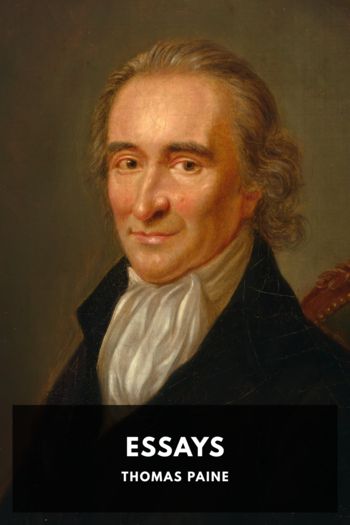The Age of Reason by Thomas Paine (icecream ebook reader TXT) 📕

- Author: Thomas Paine
Book online «The Age of Reason by Thomas Paine (icecream ebook reader TXT) 📕». Author Thomas Paine
Paine’s mind was by no means skeptical, it was eminently instructive. That he should have waited until his fifty-seventh year before publishing his religious convictions was due to a desire to work out some positive and practicable system to take the place of that which he believed was crumbling. The English engineer Hall, who assisted Paine in making the model of his iron bridge, wrote to his friends in England, in 1786: “My employer has Common Sense enough to disbelieve most of the common systematic theories of Divinity, but does not seem to establish any for himself.” But five years later Paine was able to lay the cornerstone of his temple: “With respect to religion itself, without regard to names, and as directing itself from the universal family of mankind to the Divine object of all adoration, it is man bringing to his Maker the fruits of his heart; and though those fruits may differ from each other like the fruits of the earth, the grateful tribute of everyone, is accepted.” (Rights of Man. See my edition of Paine’s Writings, II, p. 326.) Here we have a reappearance of George Fox confuting the doctor in America who “denied the light and Spirit of God to be in everyone; and affirmed that it was not in the Indians. Whereupon I called an Indian to us, and asked him ‘whether or not, when he lied, or did wrong to anyone, there was not something in him that reproved him for it?’ He said, ‘There was such a thing in him that did so reprove him; and he was ashamed when he had done wrong, or spoken wrong.’ So we shamed the doctor before the governor and the people.” (Journal of George Fox, September 1672.)
Paine, who coined the phrase “Religion of Humanity” (The Crisis, VII, 1778), did but logically defend it in The Age of Reason, by denying a special revelation to any particular tribe, or divine authority in any particular creed of church; and the centenary of this much-abused publication has been celebrated by a great conservative champion of Church and State, Mr. Balfour, who, in his Foundations of Belief, affirms that “inspiration” cannot be denied to the great Oriental teachers, unless grapes may be gathered from thorns.
The centenary of the complete publication of The Age of Reason, (October 25, 1795), was also celebrated at the Church Congress, Norwich, on October 10, 1895, when Professor Bonney, F.R.S., Canon of Manchester, read a paper in which he said: “I cannot deny that the increase of scientific knowledge has deprived parts of the earlier books of the Bible of the historical value which was generally attributed to them by our forefathers. The story of Creation in the Book of Genesis, unless we play fast and loose either with words or with science, cannot be brought into harmony with what we have learnt from geology. Its ethnological statements are imperfect, if not sometimes inaccurate. The stories of the Fall, of the Flood, and of the Tower of Babel, are incredible in their present form. Some historical element may underlie many of the traditions in the first eleven chapters in that book, but this we cannot hope to recover.” Canon Bonney proceeded to say of the New Testament also, that “the Gospels are not so far as we know, strictly contemporaneous records, so we must admit the possibility of variations and even inaccuracies in details being introduced by oral tradition.” The Canon thinks the interval too short for these importations to be serious, but that any question of this kind is left open proves the Age of Reason fully upon us. Reason alone can determine how many texts are as spurious as the three heavenly witnesses (1 John 5:7), and like it “serious” enough to have cost good men their lives, and persecutors their charities. When men interpolate, it is because they believe their interpolation seriously needed. It will be seen by a note in Part II of the work, that Paine calls attention to an interpolation introduced into the first American edition without indication of its being an editorial footnote. This footnote was: “The book of Luke was carried by a majority of one only. Vide Moshelm’s Ecc. History.” Dr. Priestley, then in America, answered Paine’s work, and in quoting less than a page from The Age of Reason he made three alterations—one of which changed “church mythologists” into “Christian mythologists,”—and also raised the editorial footnote into the text, omitting the reference to Mosheim. Having done this, Priestley writes: “As to the gospel of Luke being carried by a majority of one only, it is a legend, if not of Mr. Paine’s own invention, of no better authority whatever.” And so on with further castigation of the author for what he never wrote, and which he himself (Priestley) was the unconscious means of introducing into the text within the year of Paine’s publication.
If this could be done, unintentionally by a conscientious and exact man, and one not unfriendly to Paine, if such a writer as Priestley could make four mistakes in citing half a page, it will appear not very wonderful when I state that in a modern popular edition of





Comments (0)